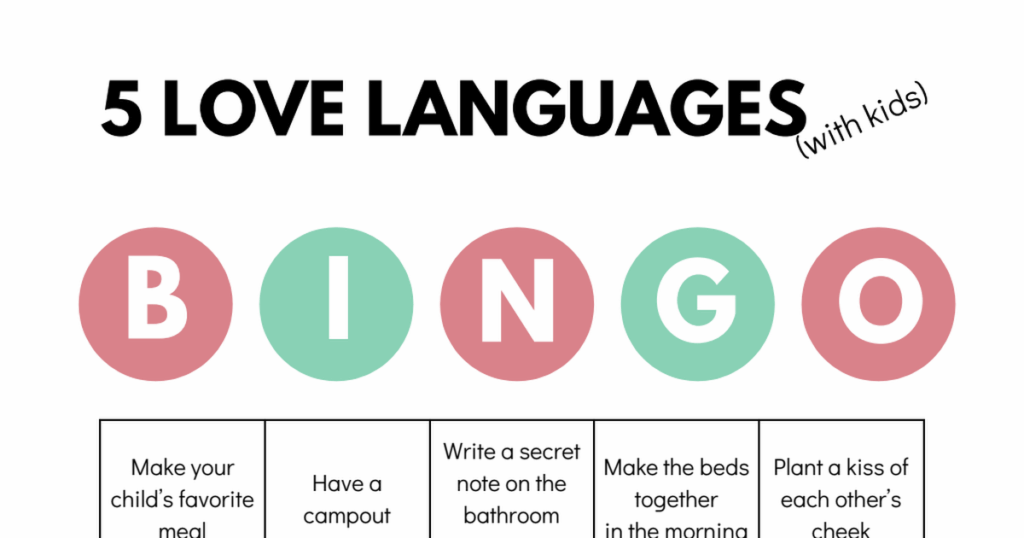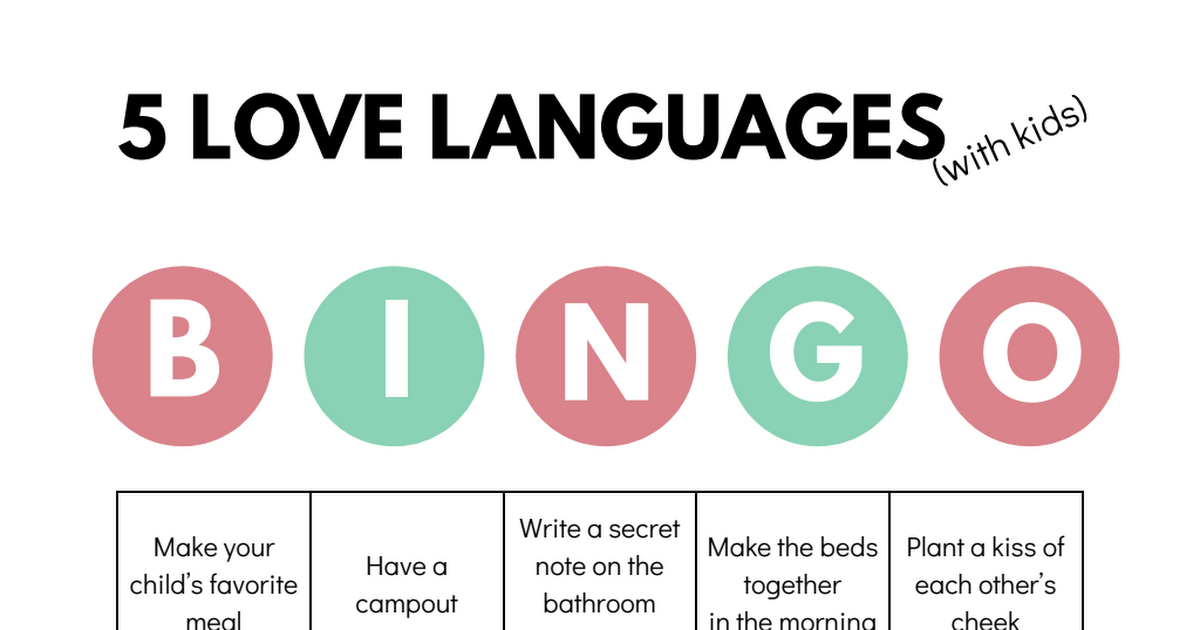
Decoding Affection: Understanding the Love Languages of Kids
Understanding how your child best receives love and affection is crucial for fostering a strong, healthy relationship. Just as adults communicate and receive love differently, children also have unique preferences. These preferences are often categorized into what are known as the “love languages kids” speak. Learning to identify and speak these languages can significantly improve your connection with your child, leading to greater emotional well-being and stronger family bonds. This article dives deep into the five love languages kids use, providing practical examples and strategies for parents to effectively communicate their love.
The Five Love Languages: A Foundation for Connection
The concept of love languages, popularized by Gary Chapman, outlines five primary ways individuals express and experience love. While originally developed for adult romantic relationships, these principles are equally applicable, if not more so, to understanding children. The five love languages kids utilize are:
- Words of Affirmation
- Acts of Service
- Receiving Gifts
- Quality Time
- Physical Touch
Each child has a primary love language, although they may appreciate and respond to all five to varying degrees. Identifying your child’s primary love language is the first step in effectively communicating your love and support.
Words of Affirmation: Speaking Volumes of Love
For children whose primary love language is words of affirmation, verbal expressions of love, appreciation, and encouragement are deeply meaningful. These children thrive on hearing positive feedback and knowing that they are valued and appreciated. It’s more than just saying “I love you”; it’s about providing specific, genuine compliments and acknowledgements.
Examples of Words of Affirmation
- “I’m so proud of how hard you worked on that project!”
- “You have such a kind heart. I saw you helping your friend today, and it made me so happy.”
- “I love your creativity! That drawing is amazing.”
- “Thank you for helping with the dishes. I really appreciate it.”
- “You’re a great listener. I enjoy talking to you.”
The key is to be sincere and specific. Generic praise can feel empty, while targeted compliments demonstrate that you truly notice and appreciate your child’s efforts and qualities. Avoid sarcasm or negative criticism, as these can be particularly damaging to a child whose love language is words of affirmation. [See also: Positive Parenting Techniques]
Acts of Service: Actions Speak Louder Than Words
For children who resonate with acts of service, actions truly speak louder than words. These children feel loved and cared for when others do things for them, especially when those actions are thoughtful and demonstrate a willingness to help. It’s about alleviating burdens and showing that you are willing to invest your time and energy to make their lives easier.
Examples of Acts of Service
- Making their favorite breakfast
- Packing their lunch
- Helping with homework
- Driving them to activities
- Folding their laundry
- Helping them clean their room (without nagging!)
It’s important to note that acts of service should not be confused with enabling or doing everything for your child. The goal is to provide support and assistance, not to prevent them from developing independence and responsibility. Focus on tasks that genuinely alleviate stress or demonstrate your care and attention. If your child’s love language is acts of service, they will greatly appreciate these gestures.
Receiving Gifts: Tangible Tokens of Affection
Children whose primary love language is receiving gifts value tangible tokens of affection. This doesn’t necessarily mean expensive or extravagant presents. The thought and effort behind the gift are what truly matter. It’s about knowing that someone was thinking of them and took the time to choose something special.
Examples of Receiving Gifts
- A small, thoughtful gift (e.g., a favorite candy, a new book, a small toy)
- A handmade card or drawing
- Flowers picked from the garden
- A framed photograph
- A souvenir from a trip
The value of the gift is less important than the sentiment behind it. A child whose love language is receiving gifts will cherish even the smallest, most inexpensive presents if they know it was given with love. Avoid giving gifts out of obligation or as a substitute for quality time or affection. The goal is to show that you are thinking of them and that you care about their interests and desires. Birthdays and holidays are not the only opportunities for gift-giving; a random act of kindness can be even more meaningful. Understanding the love languages kids use will help you pick the right gifts.
Quality Time: Undivided Attention and Connection
For children who thrive on quality time, undivided attention and focused interaction are essential. These children feel loved and valued when they have your full attention, free from distractions. It’s about creating meaningful moments and shared experiences that foster a strong connection.
Examples of Quality Time
- Playing a game together
- Reading a book aloud
- Going for a walk or bike ride
- Having a conversation without distractions
- Working on a project together
- Simply sitting and cuddling
The key to quality time is to be present and engaged. Put away your phone, turn off the television, and focus solely on your child. Let them choose the activity, and be willing to participate fully, even if it’s not something you particularly enjoy. It’s about creating a shared experience and showing that you value their company. Even short bursts of focused attention can be incredibly meaningful for a child whose love language is quality time. [See also: Family Activities for Bonding]
Physical Touch: The Power of Connection
Children whose primary love language is physical touch feel loved and secure through physical affection. This can include hugs, kisses, cuddles, high-fives, and other forms of physical contact. It’s about feeling physically connected and knowing that they are safe and protected.
Examples of Physical Touch
- Hugs and kisses
- Cuddling on the couch
- Holding hands
- Giving a back rub
- Playing with their hair
- High-fives and fist bumps
It’s important to be mindful of your child’s boundaries and preferences. Some children are more comfortable with physical touch than others. Pay attention to their cues and respect their personal space. Never force physical affection, and always ensure that any physical contact is appropriate and respectful. For children whose love language is physical touch, these simple gestures can be incredibly reassuring and comforting. Understanding the love languages kids use is important for their emotional development.
Identifying Your Child’s Love Language
Discovering your child’s primary love language requires observation, experimentation, and communication. Here are some tips for identifying your child’s love language:
- Observe their behavior: Pay attention to how your child expresses love and affection to others. They often give love in the way they prefer to receive it.
- Listen to their requests: What do they ask for most often? Do they crave your attention, your help, or your praise?
- Experiment with different love languages: Try incorporating each of the five love languages into your interactions with your child and see which ones elicit the strongest positive response.
- Ask them directly: Have a conversation with your child about how they feel most loved and appreciated.
- Consider their age: Younger children may be more receptive to physical touch and quality time, while older children may appreciate words of affirmation and acts of service.
Speaking Your Child’s Love Language: Practical Tips
Once you’ve identified your child’s primary love language, it’s important to make a conscious effort to speak that language regularly. Here are some practical tips for incorporating each of the five love languages into your daily interactions with your child:
- Words of Affirmation: Offer specific praise and encouragement. Write them a note or send them a text message. Tell them how much you appreciate them.
- Acts of Service: Help them with tasks that they find challenging. Offer to run errands for them. Make their favorite meal.
- Receiving Gifts: Give them small, thoughtful gifts. Create a scavenger hunt with a small prize at the end. Leave a surprise note in their lunchbox.
- Quality Time: Schedule dedicated time to spend with them, free from distractions. Let them choose the activity. Be fully present and engaged.
- Physical Touch: Offer hugs, kisses, and cuddles regularly. Hold their hand while walking. Give them a back rub before bedtime.
The Benefits of Speaking Your Child’s Love Language
Communicating with your child in their primary love language offers numerous benefits, including:
- Strengthened bond: When children feel loved and understood, they are more likely to develop a strong, secure attachment to their parents.
- Improved communication: Children who feel loved and valued are more likely to communicate openly and honestly with their parents.
- Increased self-esteem: Feeling loved and accepted can boost a child’s self-esteem and confidence.
- Reduced behavioral problems: Children who feel loved and supported are less likely to exhibit behavioral problems.
- Greater emotional well-being: Feeling loved and secure can promote a child’s overall emotional well-being and resilience.
Common Mistakes to Avoid
While understanding and speaking your child’s love language is beneficial, it’s important to avoid some common mistakes:
- Assuming your child’s love language is the same as yours: Each child is unique and has their own preferences.
- Focusing solely on one love language: While it’s important to prioritize your child’s primary love language, it’s also beneficial to incorporate all five love languages into your interactions.
- Using love languages as a form of manipulation: Love languages should be used to express genuine affection, not to control or manipulate your child’s behavior.
- Neglecting other important aspects of parenting: Love languages are just one piece of the puzzle. It’s also important to provide structure, discipline, and guidance.
Conclusion: Building a Foundation of Love
Understanding the love languages kids respond to is a powerful tool for fostering strong, healthy relationships with your children. By identifying their primary love language and making a conscious effort to speak that language regularly, you can create a foundation of love, trust, and connection that will benefit your child for years to come. Remember that it’s an ongoing process of learning, observation, and communication. Be patient, be open-minded, and be willing to adapt your approach as your child grows and changes. By prioritizing their emotional needs and communicating your love in a way that resonates with them, you can create a truly fulfilling and meaningful relationship. Recognizing and responding to the love languages kids use is a cornerstone of effective parenting.

